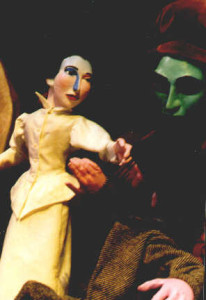When we talk about voice in writing, it can get confusing because people use the word to mean different things. Let me offer “style of puppetry” as a metaphor to talk about the different forms of voice.
Mechanical
In puppetry one of the first things you have to do when designing a new show is decide what style of puppet you are going to use. By this, we mean the mechanical style. Are you using marionettes? Rod puppets? Glove puppets?
For writers, this mechanical voice relates to Person and Tense. 1st person? 3rd person? 2nd person plural, future tense?
Aesthetic
The aesthetic style of a puppet relates to the design elements. Are you trying to look like the puppets are in the style of Chagal or fuzzy like a Muppet?
For writers, this aesthetic voice relates to the narrative tone. You might go for sounding like Jane Austen, or rural Appalachian, or 21st century Anglo-American.
Personal
This relates to the small personal idiosyncrasies of the performer. You can hand the same puppet to two different puppeteers and you can totally tell who is working it even if the performer can do an aesthetic match of the original puppeteers voice. The differences are minute details of timing, choice, and movement that all relate to the puppeteer’s background and personality.
Take a look at these two clips of Sam the Eagle, starting with original Sam, performed by Frank Oz.
And now modern Sam, performed by Eric Jacobson.
Eric is a phenomenally good puppeteer, but you can tell that it’s two different people even though most of you reading this aren’t puppeteers. I can point to the use of the eye mechanism, differences in fluidity of neck movement, and other dynamics, all of which relate to individual performer choices.
For writers, those individual choices come from your background, your lived experience, your taste and interests. I can teach mechanical and aesthetic voice, but I can’t teach personal voice. That personal voice though, that thing that is absolutely unique to you as a writer is why you must write.
No one else can write the things you will write in the way that you write them. You have a voice. Use it.

When Kermit changed performers 🙁 I was seriously disturbed down in my little kid brain even though I was 30+ It was so wrong.
I literally had to tell myself that Kermie had had a massive stroke and that’s why he had been away for so long and now he moved and talked differently.
It’s been long enough that I’m okay now.
Ah, Kermit.
Many years ago, I had the privilege of attending a talk by Jim Henson. The lanky bearded man came out on stage (to thunderous applause) and talked about what was coming out for the Muppets.
Then he said something on the lines of “but this is why you’re really here,” and pulled out Kermit from the podium. Once the words “Hi-ho! Kermit the Frog here” were said, the lanky bearded man (whoever he was) just kinda disappeared. Henson didn’t need to be a ventriloquist, because who would look at him while the Frog was talking?
To bring this back to voice, in an undergrad poetry class, when some of my classmates weren’t getting voice and persona (as it applies to poetry), I brought up the Archy and Mehitabel poems. Most of the poems are narrated by one or the other, a cockroach and a cat, although they were written by Don Marquis.
On the page—no strings—Marquis talked through the voice of a free verse poet reincarnated as a cockroach, and a cat who claimed to have once been Cleopatra. As Archy quoted her:
there s a dance in the old dame yet